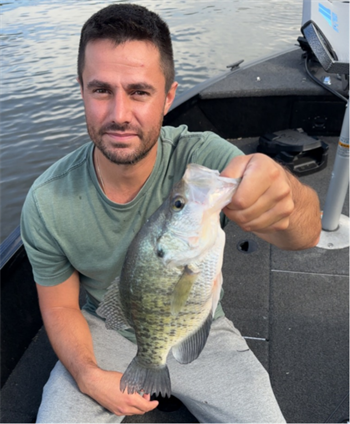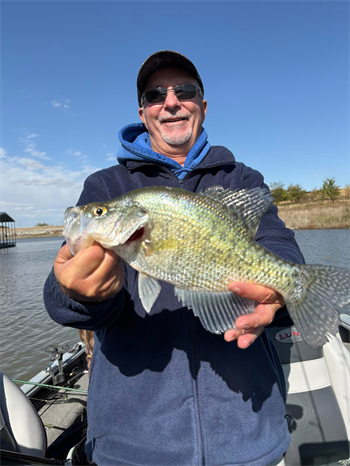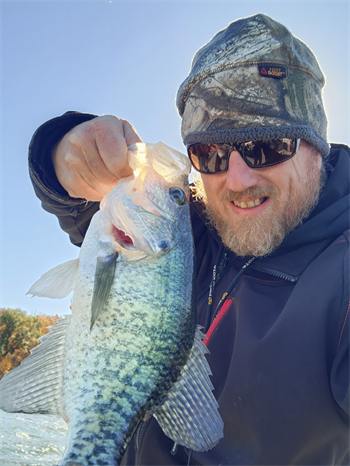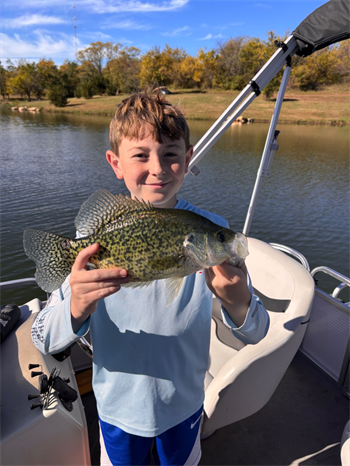Fish Iowa - Fish Species - White Crappie
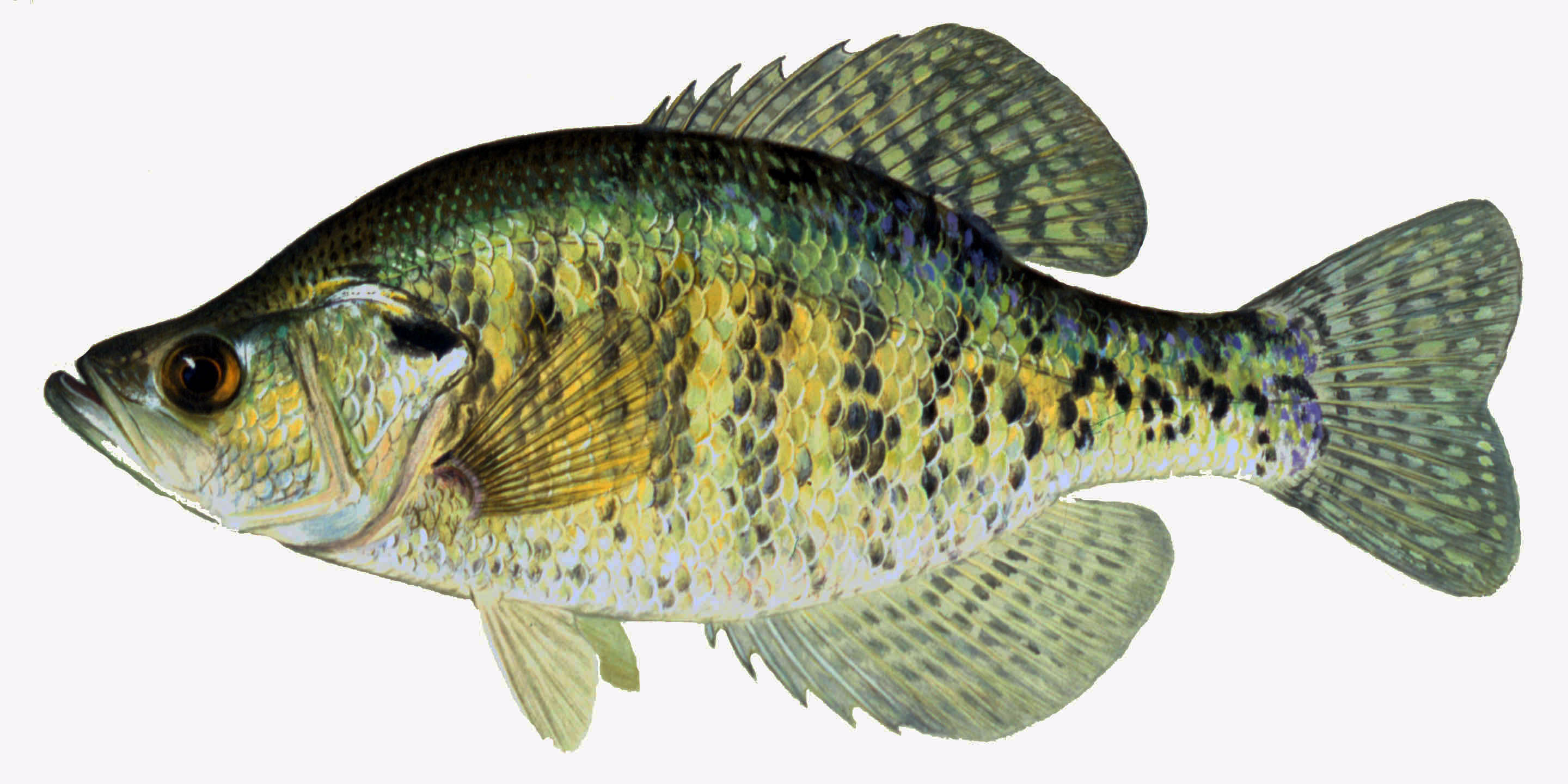
Characteristics
A silvery, deep-bodied, slab-sided fish with a mouth that is proportional to body size. The upper jaw reaches well past the middle of the eye when the mouth is closed. The silvery-colored body shades to green or brown on the back. There are several, usually 7 to 9, vertical dark bars on the sides, and the belly is bright silver or white. The spiny dorsal and soft dorsal fins are broadly connected without a notch between. The anal fin is usually as long and as large as the dorsal fin and has 6 spines. The dorsal fin has 6 spines and the length of its base is much less than the distance from the eye to the front of the dorsal fin. Breeding males become much darker and vividly marked during spawning; females retain their usual coloration and markings. White Crappie have a ski-slope shaped nasal structure, and the forward part of the back is strongly concave.
Foods
- No results found
Expert Tip
crappie have delicate mouths, don't get carried away when you set the hook, a firm tug is plenty to set the hook
Details
White Crappie tolerate turbid waters better than Black Crappie and are more abundant in waters that have lots of silt. It is abundant in all reaches of the Mississippi River. Some of the large interior streams have dense populations of White Crappie. Many farm ponds have been stocked with White Crappie, but their well-being in these small water bodies is seldom satisfactory.
White Crappie young feed mostly on copepods, cladocerans and other zooplankton during the first year of life. During late summer of their first year, young crappie start to eat aquatic insects, which remain an important food item for the rest of their life. Crappie start to eat small fish in the second year, which become the staple food in adulthood.
White Crappie spawn in late April or early May when the water temperature reaches 56 degrees. The male crappie fans out a depression in the bottom, usually in a cove or small embayment that is protected from wave action. Many nests may be found in a cove at depths from 1 to 20 feet, but usually 3 to 10 feet. Female White Crappie enter the spawning area and deposit their eggs in one or more of the nests, which are immediately fertilized by the male fish. The number of eggs in a crappie nest varies, but a nest can hold up to 20,000.
The eggs hatch in about 3 days and the sac-fry remain attached to the substrate for several more days. After the yolk sac is absorbed, the young fish free themselves from the bottom by swimming vigorously. The fry leave the nest only at night and do not gather in schools.
Growth of White Crappie in Iowa averages about 2- to 3-inches in the first year, reaching 10- to 12-inches by the fourth year. Crappie seldom exceed 2-pounds in Iowa.
Recent stream sampling information is available from Iowa DNR's biological monitoring and assessment program.
Learn more about this fish at the Crappie Profile DNR Homepage
Distribution Map

statewide in lakes and large rivers
See our most recent distribution data for this species on the Iowa DNR's Bionet application.
State Record(s)
Master Angler Catches
Fish Surveys
Tip: Click Species Length by Site, then use the dropdown to filter by fish species of interest.Where this Fish Is Found
Alice Wyth Lake
Armstrong Park Pond
Atlantic Quarry Pond 1
Atlantic Quarry Pond 2
Atlantic Quarry Pond 3
Backbone Lake
Badger Creek Lake
Beeds Lake
Big Creek Lake
Big Sioux River
Big Timber Complex
Big Woods Lake
Binder Lake
Black Pit
Brinker Lake
Burlington Street Dam
Bussey Lake
Cedar Falls Impoundment
Cedar Lake
Cedar Lake
Cedar River (Cedar Rapids to Moscow)
Cedar River (La Porte City to Cedar Rapids)
Cedar River (Nashua to La Porte City)
Center Lake
Centerville Upper Reservoir
Clear Lake
Coralville Reservoir
Crystal Lake Sediment Pond
Des Moines River (Saylorville to Red Rock)
Des Moines River (Stratford to Saylorville Lake)
Diamond Lake
Don Williams Lake
East Lake (Lenox)
Ellis Lake
Five Island Lake
Folsom Lake
Gateway Park North
George Wyth Lake
Glenwood Lake
Grays Lake
Green Belt Lake
Green Valley Lake
Greenfield Lake
Harold Getty Lake
High Lake
Ingham Lake
Interstate Park Lake
Iowa River (Coralville Lake to River Junction)
Iowa River (Iowa Falls to Marshalltown)
Iowa River (Marshalltown to Coralville Lake)
Jacob Krumm Nature Preserve Lake (west)
Johnston Commons East
Lake Cornelia
Lake Delhi
Lake Fisher
Lake Icaria
Lake Macbride
Lake of Three Fires
Liberty Lake
Little Sioux River (state line to Linn Grove)
Little Spirit Lake
Little Wall Lake
Loch Ayr
Lost Grove Lake
Lower Gar Lake
Lower Pine Lake
Maquoketa River (below Monticello)
Martens Lake
McKinley Lake
Meadow Lake
Meyers Lake
Minnewashta Lake
Missouri River (Council Bluffs to state line)
Missouri River (Little Sioux to Council Bluffs)
Missouri River (Sioux City to Little Sioux)
Mohawk Park Lake
Nodaway Lake
Pilot Grove Lake
Pioneer Park Pond
Pony Creek Lake
Pool 09, Mississippi River
Pool 11, Mississippi River
Pool 13, Mississippi River
Pool 14, Mississippi River
Pool 16, Mississippi River
Pool 17, Mississippi River
Pool 18, Mississippi River
Pool 19, Mississippi River
Prairie Park Fishery
Purple Martin Lakes
Q Pond City Park
Quarry Springs
RAPP Park Lakes
Rathbun Reservoir
RecPlex Pond
Red Rock Reservoir
Ross Area Pit
Sand Lake
Saylorville Reservoir
Seminole Valley Park Lakes
Seymour Reservoir
Silver Lake (Dickinson)
Slip Bluff Lake
Summit Lake
Terry Trueblood Lake
Three Mile Lake
Trestle Pointe Park Pond
Tuttle Lake
Twelve Mile Creek Lake
Upper Gar Lake
Upper Pine Lake
Viking Lake
Wapsipinicon River (Troy Mills to Oxford Junction)
West Lake (Lenox)
West Lake (Osceola)
West Okoboji Lake
West Pond
West Swan Lake S.W.M.A.
Wilson Park Lake
Windmill Lake

